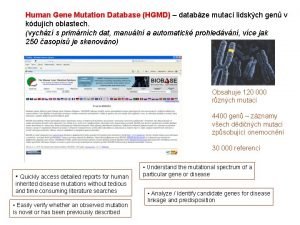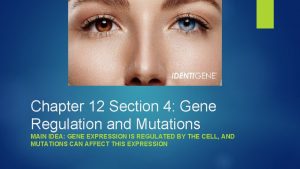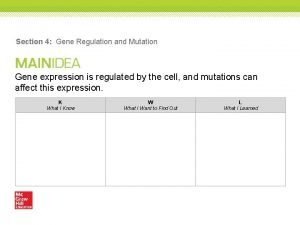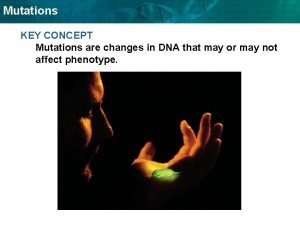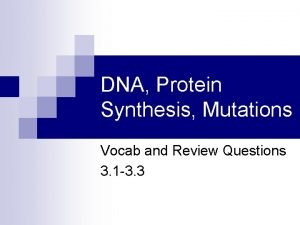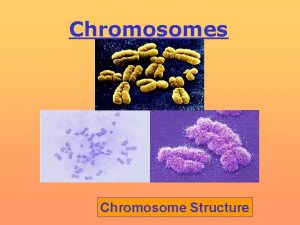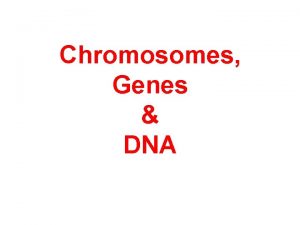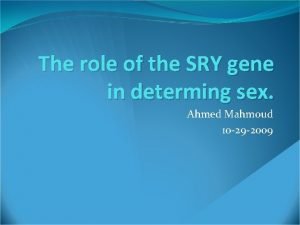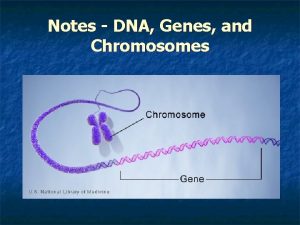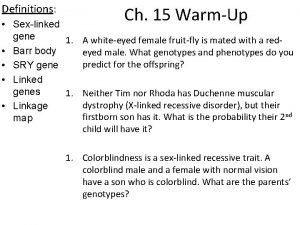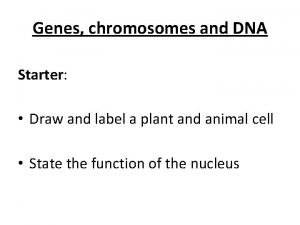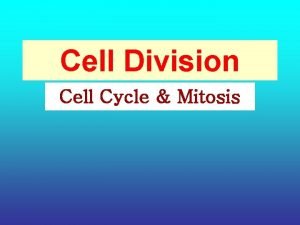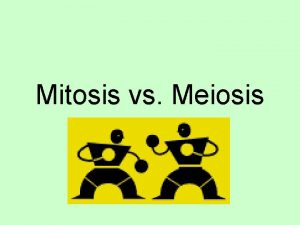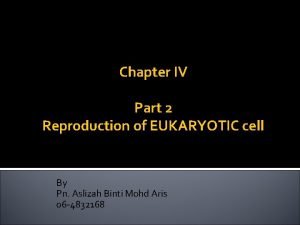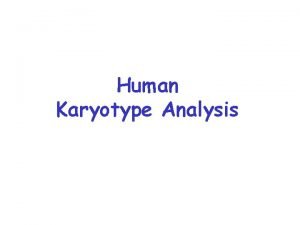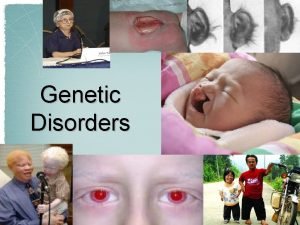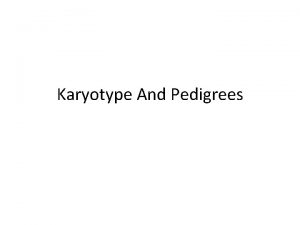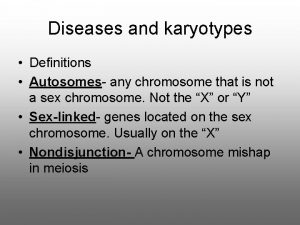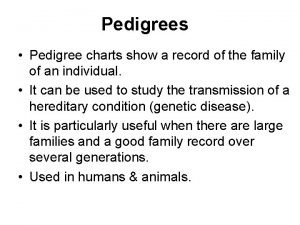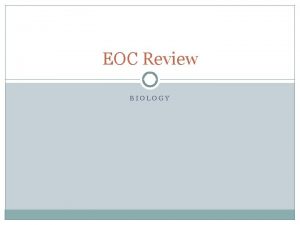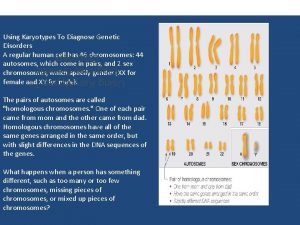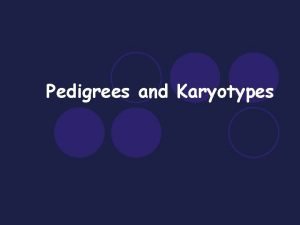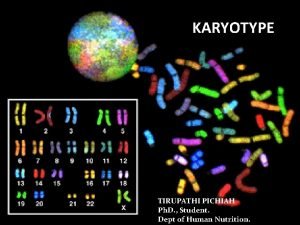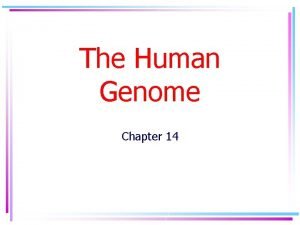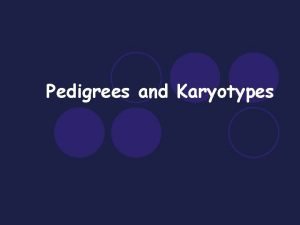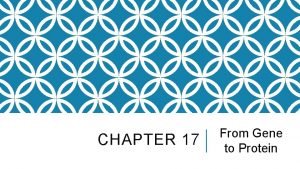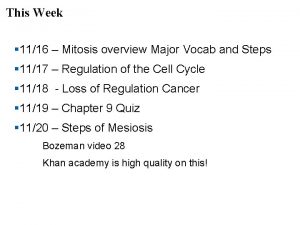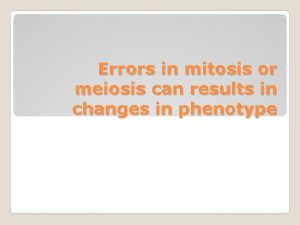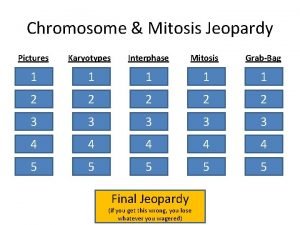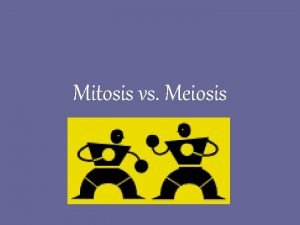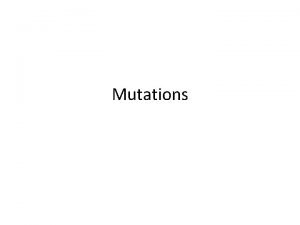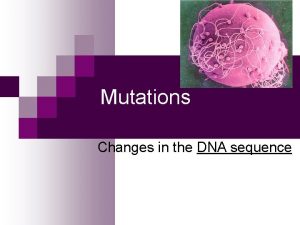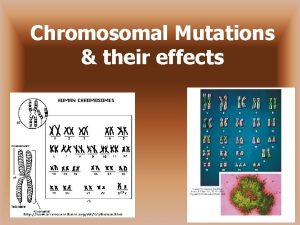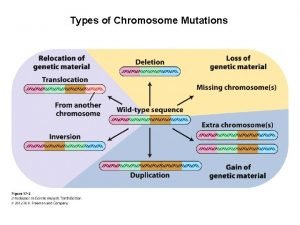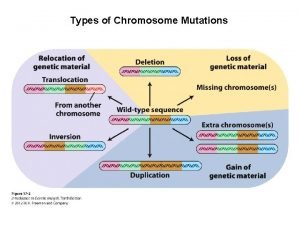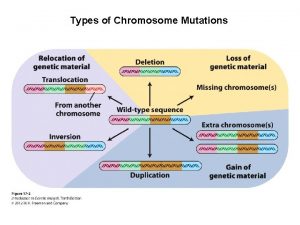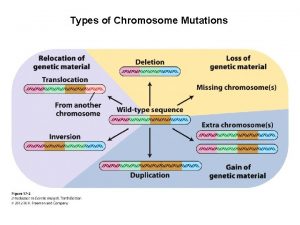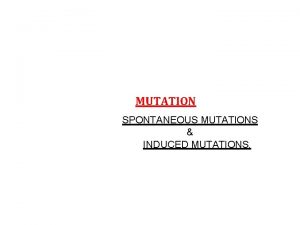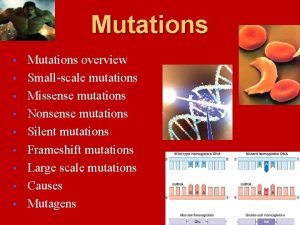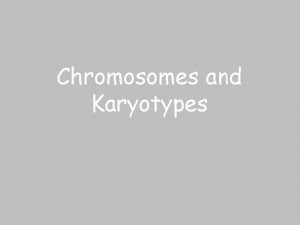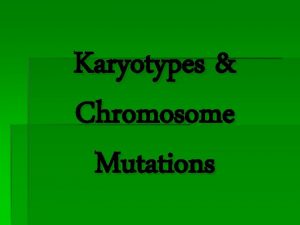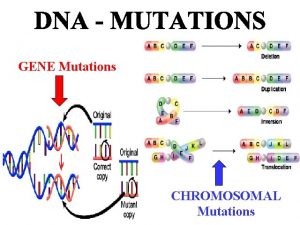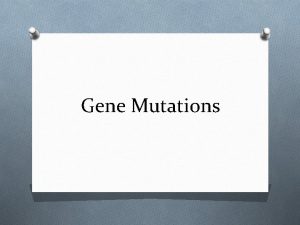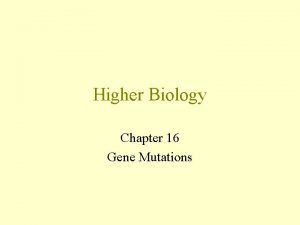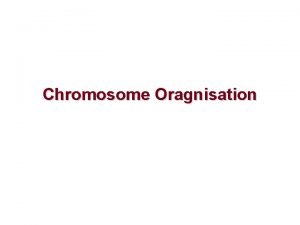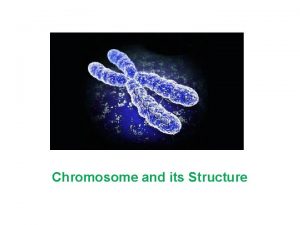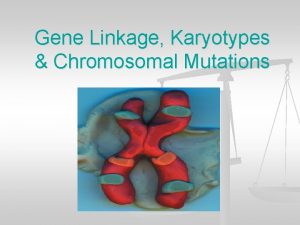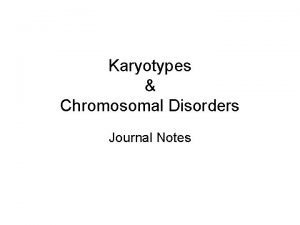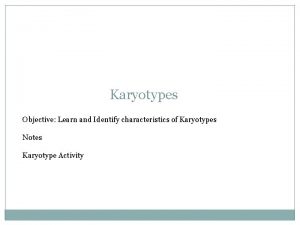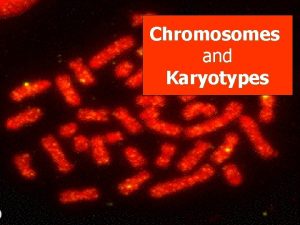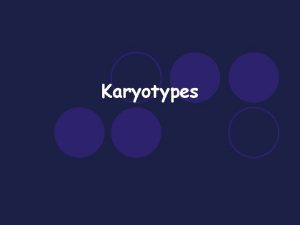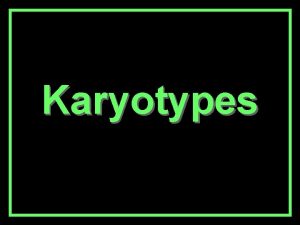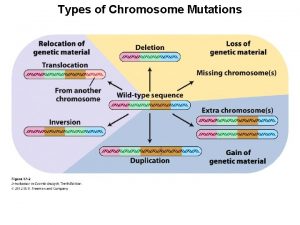Jeopardy Mitosis Gene to Protein Mutations Chromosome Karyotypes









































- Slides: 41

Jeopardy Mitosis Gene to Protein Mutations Chromosome/ Karyotypes Q $100 Q $200 Q $300 Q $400 Q $500

$100 Question: Mitosis What are the four phases of mitosis? What do we call the phase leading up to mitosis?

$100 Answer: Mitosis 1. Prophase Metaphase Anaphase Telophase 2. Interphase

$200 Question: Mitosis A crayfish cell has 200 total or 100 pairs of chromosomes. Following mitosis, the daughter cells would each have a total of ______ chromosomes. a. 200 b. 100 c. 400 d. 50 e. 46

$200 Answer: Mitosis A. 200 After mitosis, the daughter cells have an identical number of chromosomes.

$300 Question: Mitosis Which of these phases is prophase? How do you know?

$300 Answer: Mitosis The third from the left. The chromosomes begin to form, as do the spindle fibers.

$400 Question: Mitosis While modeling mitosis, Sherri arranges the chromosomes in metaphase like this: While modeling mitosis, La. Rita arranges the chromosomes in metaphase like this: Will the daughter cells in Sherri’s model be genetically the same as or different from the daughter cells in La. Rita’s model? WHY or WHY NOT?

$400 Answer: Mitosis Sherri and La. Rita’s daughter cells will be genetically identical, since the order in which chromosomes line up during mitosis doesn’t matter. Chromosomes line up INDEPENDENTLY of each other!

$500 Question: Mitosis Komodo dragons, the world’s biggest lizards, generally reproduce sexually, but can switch to parthenogenesis (asexual reproduction) if mates are not available. Why do you think komodo dragons usually reproduce sexually? What advantage does sexual reproduction have in the types of offspring produced over asexual reproduction?

$500 Answer: Mitosis Sexual reproduction takes more energy (finding a suitable mate, etc. ), but has the advantage of producing a variety of offspring. If there is a variety offspring, your offspring are more likely to survive and reproduce. Identical offspring may or may not survive various diseases or other challenges - but will do so in similar ways.

$100 Question: Gene to Protein What does DNA stand for? Name two people responsible for characterizing the structure of DNA.

$100 Answer: Gene to Protein Deoxyribonucleic acid. James Watson, Francis Crick, Rosalind Franklin and Maurice Wilkins.

$200 Question: Gene to Protein Name three parts of a DNA nucleotide. Why is DNA called a “double helix? ”

$200 Answer: Gene to Protein Nucleotide: deoxyribose/sugar; phosphate group; nitrogenous base. Double helix - it has two sugar-phophate backbones that form a spiral shape.

$300 Question: Gene to Protein Transcribe and translate the following DNA sequence into an m. RNA and amino acid sequence: DNA 1: TCA GGC GAC AAT

$300 Answer: Gene to Protein DNA 1: TCA GGC GAC AAT m. RNA: AGU CCG CUG UUA Amino acid sequence: Serine-Proline -Leucine

$400 Question: Gene to Protein Compare and contrast transcription and translation. Name at least three similarities and three differences.

$400 Answer: Gene to Protein Transcription Same Makes messenger RNA Converts one kind of information into From DNA another form Uses base-pairing rules Used in protein (AU, CG) production Occurs in nucleus Uses DNA as source information Translation Uses t. RNA, m. RNA, and ribosomes Translates language of nucleic acids into amino acids Occurs in cytoplasm

$500 Question: Gene to Protein The HIV virus invades cells by injecting its m. RNA into cells. m. RNA disintegrates rapidly. How do you think the HIV virus is able to keep its genetic information in cells longterm?

$500 Answer: Gene to Protein Return

$100 Question: Mutations List and define three types of mutation.

$100 Answer: Mutations Point/substitution mutation - changing one base in the code for another. Insertion - adding a base, causing a frameshift and a missense mutation. Deletion - removing a base, causing a frameshift and a missense mutation.

$200 Question: Mutations The following shows an original DNA sequence one that has been mutated. What kind of mutation is this? How do you know? DNA (original): CTT ACG GGA TCA DNA (mutated): CTT CGG GAT CA

$200 Answer: Mutations Deletion mutation, because a letter has been removed. A frameshift has occurred. One of the codon now only has two letters and the rest have been altered.

$300 Question: Mutations In the mutation for the trait for sickle cell anemia, a genetic disorder that causes sickle-shaped blood cells, only one base is changed, as seen below. What effect will this have on the resulting amino acid sequence? Normal GGG CTT TTT Hemoglobin Sickled GGG CAT CTT TTT Hemoglobin

$300 Answer: Mutations Normal: Proline – Glutamic Acid - Lysine Sickled: Proline – Valine – Glutamic Acid – Lysine One amino acid has changed: Glutamic acid --> Valine is very hydrophobic, so it causes the protein to fold incorrectly, leading to the sickle cell disease.

$400 Question: Mutations Sickle cell anemia is a potentially fatal recessive condition caused by a point mutation. Individuals who are homozygous recessive for the trait have the condition. Those who are heterozygous for the trait do not have the trait and are resistant to malaria, a disease that destroys red blood cells. Those who are homozygous dominant do not have the trait, but are not resistant to malaria. If given a choice, would you rather be homozygous recessive, heterozygous or homozygous dominant? Consider the consequences for yourself AND your potential offspring.

$400 Answer: Mutations Homozygous recessive - have the disease; it’s painful and potentially fatal; don’t get malaria; pass on sickle cell allele to offspring. Heterozygous: have one mutant allele, one normal allele; don’t get malaria; don’t get sickle cell; may or may not pass on the trait. Homozygous dominant: don’t have sickle cell; may or may not get malaria; will not pass on sickle trait to your children.

$500 Question: Mutations Mutation is sometimes called the raw material for evolution and natural selection. How does mutation generate genetic diversity within a population? How can that diversity be helpful to an individual? To a population?

$500 Answer: Mutations provide genetic diversity by changing organisms’ genetic information. That information may help, be neutral, or hurt the individual. If it helps, we call it an adaptation. Those organisms that have adaptations survive and reproduce better and can eventually become the majority of a population.

$100 Question: Chromosomes/Karyotype What is the centromere?

$100 Answer: Chromosomes/Karyotype The centromere holds the sister chromatids together.

$200 Question: Chromosomes/Karyotype A person is born with the genotype XXY. What syndrome is the person likely to have? What gender will they be (genetically)? How do you know?

$200 Answer: Chromosomes/Karyotype Klinefelter’s syndrome. XXY = male in humans. In humans, the presence or absence of a Y chromosome determines gender.

$300 Question: Chromosomes/Karyotype Why is DNA transported in chromosomes during cell division? Your answer MUST use the following terms: DNA, proteins, chromosome, and histones.

$300 Answer: Chromosomes/Karyotypes Cells transport DNA in chromosomes because chromosomes can move DNA easily. Chromosomes wind chromatin (which is long thin threads of DNA) around proteins called histones. Cells use chromosomes because they compact the DNA and prevent it from tangling/tearing.

$400 Question: Chromosomes/Karyotypes A karyotype is shown below. Diagnose the syndrome and list possible symptoms. What is this person’s gender?

$400 Answer: Chromosomes/Karyotypes The karyotype has trisomy 21, so they may have Down syndrome. Symptoms of Down syndrome include delayed mental development, characteristic facial features, hands with a deep crease in the palm, shortened life span, etc. Because of the presence of a Y chromosome, this person is genetically male.

$500 Question: Chromosomes/Karyotypes Imagine you are a doctor and you perform a karyotype on a newborn baby that was born intersex (they hadn’t developed male or female genitalia fully). You find that the baby is XXY. What advice would you give to the parents regarding surgery to assign their child a gender?

$500 Answer: Chromosomes/Karyotypes Their child is genetically male, so should be assigned male genitalia. Their child is genetically male, but has Klinefelter’s syndrome, which limits male development. Therefore, it will be easier for their child to be raised female. (ETC. - ANY well defended argument is acceptable. )
 Chapter 17: from gene to protein
Chapter 17: from gene to protein Gene mutations
Gene mutations Section 4 gene regulation and mutations
Section 4 gene regulation and mutations Section 4 gene regulation and mutations
Section 4 gene regulation and mutations Gene mutations
Gene mutations Missense mutation in sickle cell anemia
Missense mutation in sickle cell anemia Protein synthesis and mutations
Protein synthesis and mutations Protein synthesis and mutations
Protein synthesis and mutations Prokaryotic chromosome vs eukaryotic chromosome structure
Prokaryotic chromosome vs eukaryotic chromosome structure Gene and chromosome
Gene and chromosome Sex reversal syndrome
Sex reversal syndrome The relationship between genes dna and chromosomes
The relationship between genes dna and chromosomes Is klinefelter syndrome autosomal or sexlinked
Is klinefelter syndrome autosomal or sexlinked Define chromosome
Define chromosome Gene by gene test results
Gene by gene test results Chromosome sets (=n) in mitosis and meiosis
Chromosome sets (=n) in mitosis and meiosis Chromosome/mitosis/meiosis review answer key
Chromosome/mitosis/meiosis review answer key Chromosome sets (=n) in mitosis and meiosis
Chromosome sets (=n) in mitosis and meiosis 47 +21
47 +21 What are some uses of analyzing karyotypes?
What are some uses of analyzing karyotypes? Pedigrees and karyotypes
Pedigrees and karyotypes Autosomes in karyotypes
Autosomes in karyotypes Pedigree diagram
Pedigree diagram Reading karyotypes
Reading karyotypes Using karyotypes to diagnose genetic disorders
Using karyotypes to diagnose genetic disorders Pedigrees and karyotypes
Pedigrees and karyotypes Tirupathi pichiah
Tirupathi pichiah Chapter 14 the human genome making karyotypes answer key
Chapter 14 the human genome making karyotypes answer key Pedigrees and karyotypes
Pedigrees and karyotypes Chapter 17 from gene to protein
Chapter 17 from gene to protein Chapter 17 from gene to protein
Chapter 17 from gene to protein Bioflix activity: mitosis -- events of mitosis
Bioflix activity: mitosis -- events of mitosis Protein-protein docking
Protein-protein docking Channel vs carrier proteins
Channel vs carrier proteins Edward syndrome
Edward syndrome Meiosis jeopardy
Meiosis jeopardy Put these in order
Put these in order Mitosis jeopardy
Mitosis jeopardy Mitosis vs meiosis animation
Mitosis vs meiosis animation Chromosome mutation
Chromosome mutation Dna types of mutations
Dna types of mutations Chromosomal mutation
Chromosomal mutation

